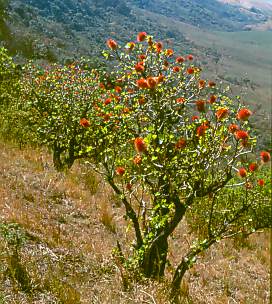Greyia sutherlandii
Greyia sutherlandii Hook. & Harv.
Family: Melianthaceae
Common names: glossy bottlebrush, mountain bottlebrush, Natal bottlebrush, wild bottlebrush, beacon tree (Eng.); blinkblaarbaakhout, Natalse baakhout (Afr.); isidwadwa, indalu, indulo, umbande (Zulu); umbere-bere, usinga-lwamaxhegokazi, indalu (Xhosa), inhlazane, umwatsawatsa (Swazi)
Introduction
This is a most decorative plant and is becoming popular as an ornamental subject in gardens.

Description
Description
Greyia sutherlandii is a large shrub or small tree, 3 to 7 m high. It is deciduous and in late autumn the leaves turn shades of bright red. Young trees are compact and old trees do not grow tall but they spread and have rough, dark trunks. The leaves are simple, alternate, rather leathery, slightly lobed and coarsely toothed. The leaf surface is hairless and minutely glandular. The leaf veins radiate from the base. The leaf stalk is long and straight.
The beautiful flowers are red, with oblong petals and long protruding stamens. The showy flowers open in closely packed racemes at the tips of the branches and bloom towards the end of winter, in spring and into early summer. The fruit is a pale brown, cone-shaped, cylindrical capsule, of 20 mm long. It splits in 4 or 5 parts when ripe to release seeds from October to December. The wood is pale pink and generally light and soft.

Conservation Status
Status
Greyia sutherlandii is not threatened, it is assessed as Least Concern (LC) in the Red List of South African Plants.
Distribution and habitat
Distribution description
Greyia sutherlandii grows on the slopes and rocky ridges of the Drakensberg up to an altitude of about 1 800 m, in the Eastern Cape, the eastern Free State, KwaZulu-Natal, Mpumalanga and Gauteng, and in Swaziland.
Derivation of name and historical aspects
History
The genus was named in honour of Sir George Grey (1812-1898) who was a Governor of the Cape Colony. He was a great patron of botany. The specific epithet honours Peter Cormack Sutherland (1822-1900), a medical doctor from Aberdeen, Scotland, who was the Surveyor-General of Natal in 1855; he made many plant collections during his term of office. He was also the first person to send specimens of the tree to England. The common name bottlebrush suggests the resemblance of the flowers to those of the common cultivated bottlebrush of the Australian genus Callistemon.
Ecology
Ecology
Greyia sutherlandii flowers attract birds, bees and other insects.
Uses
Use
The light, soft, pale pink wood of the Natal bottlebrush is known to be used to make household utensils and handicrafts. Some farmers use it for fencing, or plant it as a living fence around kraals (stock enclosures). Root infusions are used in traditional medicine to induce nausea and vomiting.
Greyia sutherlandii is more popular horticulturally than its cousin species, G. radlkoferi (woolly bottlebrush) and G. flanaganii (Kei bottlebrush). This tree is best for smaller gardens and courtyard gardens. It can also be grown in a pot.

Growing Greyia sutherlandii
Grow
Greyia sutherlandii is relatively hardy, and fairly drought resistant. Under suitable conditions with well-drained soil and good aeration, it is a fast grower but may not grow taller than 3 m in a garden. It does not flower well in coastal areas. In the winter-rainfall region it requires a well-drained position and moderate watering during summer.
Greyia sutherlandii is propagated from seed, cuttings, or suckers. Sow seed in March in a seed tray of well-drained soil. Treat seed with fungicide to prevent damping off. Keep the seed tray damp in a warm position.
Take cuttings from new shoots when the tree is in active growth. Fine bark mixed with polystyrene in a plastic multi-tray will work best. Put the cuttings on the mist unit with bottom heating. The cuttings will root in 4 to 6 weeks.
References
- Coates Palgrave, K. 1983. Trees of southern Africa. Struik, Cape Town.
- Palmer, E. & Pitman, N. 1972. Trees of southern Africa. Balkema, Cape Town.
- Pooley, E. 1993. Trees of Natal, Zululand and Transkei. Natal Flora Publications Trust, Durban.
Credits
Giles Mbambezeli
Kirstenbosch National Botanical Garden
October 2006
updated September 2016
Plant Attributes:
Plant Type: Shrub, Tree
SA Distribution: Eastern Cape, Free State, KwaZulu-Natal, Limpopo, Mpumalanga
Soil type: Sandy, Loam
Flowering season: Spring, Early Summer
PH: Acid, Neutral
Flower colour: Red
Aspect: Full Sun
Gardening skill: Average
Special Features:
Horticultural zones











Rate this article
Article well written and informative
Rate this plant
Is this an interesting plant?
Login to add your Comment
Back to topNot registered yet? Click here to register.